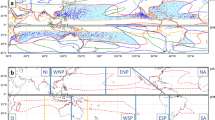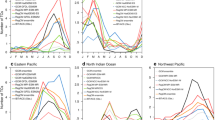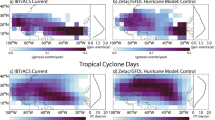Abstract
Projections of Tropical cyclone (TC) formation under future climate scenarios are dependent on climate model simulations. However, many models produce unrealistic geographical distributions of TC formation, especially in the north and south Atlantic and eastern south Pacific TC basins. In order to improve confidence in projections it is important to understand the reasons behind these model errors. However, considerable effort is required to analyse the many models used in projection studies. To address this problem, a novel diagnostic is developed that provides compelling insight into why TCs form where they do, using a few summary diagrams. The diagnostic is developed after identifying a relationship between seasonal climatologies of atmospheric variables in 34 years of ECMWF reanalysis data, and TC detection distributions in the same data. Geographic boundaries of TC formation are constructed from four threshold quantities. TCs form where Emanuel’s Maximum Potential Intensity, \(V_{{PI}}\), exceeds \(40\,\,{\text{ms}}^{{ - 1}}\), 700 hPa relative humidity, \(RH_{{700}}\), exceeds 40%, and the magnitude of the difference in vector winds between 850 and 200 hPa, \(V_{{sh}}\), is less than \(20~\,\,{\text{ms}}^{{ - 1}}\). The equatorial boundary is best defined by a composite quantity containing the ratio of absolute vorticity \((\eta )~\) to the meridional gradient of absolute vorticity (\(\beta ^{*}\)), rather than \(\eta\) alone. \({\beta ^*}\) is also identified as a potentially important ingredient for TC genesis indices. A comparison of detected Tropical Depression (TD) and Tropical Storm (TS) climatologies revealed TDs more readily intensify further to TS where \({V_{PI}}\) is elevated and \({V_{sh}}\) is relatively weak. The distributions of each threshold quantity identify the factors that favour and suppress TC formation throughout the tropics in the real world. This information can be used to understand why TC formation is poorly represented in some climate models, and shows potential for understanding anomalous TC formation behaviour in the real world.












Similar content being viewed by others
Notes
This TD, TS breakdown cannot be achieved with observed storms since no globally consistent TD database exists.
In these papers the term TC was used to describe storms of TS intensity or greater.
In Figs. 1a and 5c, d we include storms from the IBTrACS database that exceed 12 \({\rm m}{{\rm s}^{ - 1}}\) or are less than 1000 hPa if no wind data is available to represent TDs, however we expect these to be only a small subset of the true number of TDs due to the observation issues raised here.
The Duvel TD detector was recently applied to the NA basin (Duvel et al. 2017). Although not reported in that paper, they identified a subset of energetic TDs that occurred at a frequency of about 1.5 energetic TDs to every TS (S. Camargo, 2017, Pers. Comm.). This is very similar to our TD to TS detection ratio for the NA basin (Table 4) and suggests our detected TDs are likely to be equivalent to Duvel’s energetic TDs.
Anticyclonic climatological \({\eta _{850}}\)exists near the equator, typically in the summer hemisphere. Using the absolute value of \({\eta _{850}}\) here makes \(\xi\) appear more favourable than it should be, but the values are too small to affect the threshold positions.
The 700 hPa pressure level was chosen for \({\beta ^*}\) since the strongest signal occurs at this level in the Australian region, and very close to this level (650 hPa) in the eastern N Atlantic (Dickinson and Molinari 2000). Two applications of a nine-point smoothing operator have been applied, in which each grid point value takes a quarter of its original value, plus an eighth of each of the nearest grid point values, and a sixteenth of each of the neighbouring diagonal grid point values.
Saturation deficit (Eq. 2) at 700 hPa was tested as an alternative to \(R{H_{700}}\) due to suggestions that it might be a more appropriate moisture variable for comparison between present and future climate scenarios (e.g., Emanuel et al. 2008). However, the best performing (subjectively chosen) \(S{D_{700}}\) threshold values were inferior to their \(R{H_{700}}\) counterparts, and preliminary testing in a selection of CMIP5 models showed poor results.
This threshold is consistent with Korty et al. (2012b) who found (in an ensemble mean of mid-Holocene climate simulations) that for \({{V}_{{PI}}}<50~\,\,{{\rm{m}}}{{{\rm{s}}}^{ - 1}}\) the level of neutral buoyancy is confined to the lower troposphere. This suggests deep convection would be suppressed for these values of \({{V}_{{PI}}}\).
The advective \(\eta\) flux convergence is shown here since HM87 warn against separating the contributions from \(\eta\) advection and convergence due to the potential for large cancellation between the two terms.
References
Aiyyer AR, Thorncroft C (2006) Climatology of vertical wind shear over the tropical Atlantic. J Climate 19:2969–2983
Bister M, Emanuel KA (1998) Dissipative heating and hurricane intensity. Meteor Atmos Phys 65:233–240. doi:10.1007/BF01030791
Bister M, Emanuel KA (2002) Low frequency variability of tropical cyclone potential intensity. 1. Interannual to interdecadal variability. J Geophys Res 107:4801. doi:10.1029/2001JD000776
Bruyère CL, Holland GJ, Towler E (2012) Investigating the use of a genesis potential index for tropical cyclones in the North Atlantic basin. J Climate 25:8611–8626
Camargo SJ (2013) Global and regional aspects of tropical cyclone activity in the CMIP5 models. J Climate 26:9880–9902
Camargo SJ, Tippett MK, Sobel AH, Vecchi GA, Zhao M (2014) Testing the performance of tropical cyclone genesis indices in future climates using the HIRAM model. J Climate 27:9171–9196
Charney GJ, Stern ME (1962) On the stability of internal baroclinic jets in a rotating atmosphere. J Atmos Sci 19:159–172
Davis CA, Bosart LF (2003) Baroclinically induced tropical cyclogenesis. Mon Wea Rev 131:2730–2747
Dee DP, Uppala SM, Simmons AJ, Berrisford P, Poli P, Kobayashi S, Andrae U, Balmaseda MA, Balsamo G, Bauer P, Bechtold P, Beljaars, A. C. M., van de Berg L, Bidlot J, Bormann N, Delsol C, Dragani R, Fuentes M, Geer AJ, Haimberger L, Healy SB, Hersbach H, Hólm EV, Isaksen L, Kållberg P, Köhler M, Matricardi M, McNally AP, Monge-Sanz BM, Morcrette J-J, Park B-K, Peubey C, de Rosnay P, Tavolato C, Thépaut J-N, Vitart F (2011) The ERA-Interim reanalysis: configuration and performance of the data assimilation system. Quart J Roy Meteor Soc 137:553–597. doi:10.1002/qj.828
Dickinson M, Molinari J (2000) Climatology of sign reversals of the meridional potential vorticity gradient over Africa and Australia. Mon Wea Rev 128:3890–3900
Ditchek SD, Boos WR, Camargo SJ, Tippett MK (2016) A genesis index for monsoon disturbances. J Clim 29:5189–5203. doi:10.1175/JCLI-D-15-0704.1
Duvel J-P (2015) Initiation and intensification of tropical depressions over the Southern Indian Ocean: Influence of the MJO. Mon Wea Rev 143:2170–2191
Duvel J-P, Camargo SJ, Sobel AH (2017) Role of the convection scheme in modeling initiation and intensification of tropical depressions over the North Atlantic. Mon Wea Rev 145:1495–1509. doi:10.1175/MWR-D-16-0201.1
Dvorak VF (1973) A technique for the analysis and forecasting of tropical cyclone intensities from satellite pictures. NOAA Tech. Memo. NESS 45, p 19
Emanuel KA (2010) Tropical cyclone activity downscaled from NOAACIRES reanalysis, 1908–1958. J Adv Model Earth Syst. doi:10.3894/JAMES.2010.2.1
Emanuel KA, Nolan DS (2004) Tropical cyclone activity and the global climate system. Preprints. In: 26th Conf. on Hurricanes and Tropical Meteorology, Miami, Fl, Amer. Meteor. Soc., 10 A.2
Emanuel KA, Sobel A (2013) Response of tropical sea surface temperature, precipitation, and tropical cyclone-related variables to changes in global and local forcing. J Adv Model Earth Syst 5:447–458. doi:10.1002/jame.20032
Emanuel K, Sundararajan R, Williams J (2008) Hurricanes and global warming: results from downscaling IPCC AR4 simulations. Bull Amer Meteor Soc 89:347–367. doi:10.1175/BAMS-89-3-347
Ferreira RN, Schubert WH (1997) Barotropic aspects of ITCZ breakdown. J Atmos Sci 54:261–285
Frank WM (2008) What role do tropical cyclones play in the general circulation? In: Proc. 28th Conference on Hurricanes and Tropical Meteorology, 28 April–2 May 2008, Orlando, Fl, American Meteorological Society
Frank WM, Roundy PE (2006) The role of tropical waves in tropical cyclogenesis. Mon Wea Rev 134:2397–2417
Gray WM (1968) Global view of the origin of tropical disturbances and storms. Mon Wea Rev 96:669–700
Gray WM (1975) Tropical cyclone genesis. Dept. of Atmos. Sci. Paper No.232, Colorado State University, Ft. Collins, CO, p 121
Gray WM (1979) Hurricanes: their formation, structure and likely role in the tropical circulation. In: Shaw DB (ed) Meteorology over the tropical oceans. Royal Meteorological Society, pp 155–218
Haynes PH, McIntyre ME (1987) On the evolution of vorticity and potential vorticity in the presence of diabatic heating and frictional or other forces. J Atmos Sci 44:828–841
Kim J-H, Brown S, McDonald RE (2010) Future changes in tropical cyclone genesis in fully dynamic ocean- and mixed layer ocean-coupled climate models: a low-resolution model study. Clim Dyn. doi:10.1007/s00382-010-0855-6
Knapp KR, Kruk MC, Levinson DH, Diamond HJ, Neumann CJ (2010) The international best track archieve for climate stewardship (IBTrACS) unifying tropical cyclone data. Bull Am Meteor Soc 91:363–376
Knutson TR, McBride JL, Chan J-C, Emanuel K, Holland G, Landsea C, Held I, Kossin JP, Srivastava AK, Sugi M (2010) Tropical cyclones and climate change. Nat Geosci 3:157–163
Korty RL, Camargo SJ, Galewsky J (2012a) Tropical cyclone genesis factors in simulations of the Last Glacial Maximum. J Clim 25:4348–4365
Korty RL, Camargo SJ, Galewsky J (2012b) Variations in tropical cyclone genesis factors in simulations of the Holocene epoch. J Climate 25:8196–8211
McGauley MG, Nolan DS (2011) Measuring environmental favorability for tropical cyclogenesis by statistical analysis of threshold parameters. J Climate 24:5968–5997. doi:10.1175/2011JCLI4176.1
Menkes CE, Lengaigne M, Marchesiello P, Jourdain NC, Vincent EM, Lef_evre J, Chauvin F, Royer J-F (2012) Comparison of tropical cyclogenesis indices on seasonal to interannual timescales. Climate Dyn 38:301–321
Nolan DS, McGauley MG (2012) Tropical cyclogenesis in wind shear: climatological relationships and physical processes. In: Oouchi K, Fudeyasu H (eds) Cyclones: formation, triggers, and control. Chapter 1. Nova Science Publishers, Happauge, New York (ISBN 10: 1619429764; ISBN 13: 9781619429765)
Palmén EH (1948) On the formation and structure of tropical cyclones. Geophysica, Helsinki 3:26–38
Polvani LM, Camargo SJ, Garcia RR (2016) The importance of the Montreal Protocol in mitigating the potential intensity of tropical cyclones. J Climate 29:2275–2289. doi:10.1175/JCLI-D-15-0232.1
Royer J-F, Chauvin F, Timbal B, Araspin P, Grimal D, 1998: A GCM study of the impact of greenhouse gas increase on the frequency of occurrence of tropical cyclones. Clim Change 38:307–343
Tang B, Emanuel KA (2012) A ventilation index for tropical cyclones. Bull Am Meteor Soc 93:1901–1912. doi:10.1175/BAMS-D-11-00165.1
Taylor KE, Stouffer RJ, Meehl GA (2012) An overview of CMIP5 and the experiment design. Bull Am Meteor Soc 93:485–498
Tippett MK, Camargo SJ, Sobel AH (2011) A Poisson regression index for tropical cyclone genesis and the role of large-scale vorticity in genesis. J Clim 24:2335–2357
Tory KJ, Dare RA (2015) Sea surface temperature thresholds for tropical cyclone formation. J Clim 28:8171–8183
Tory KJ, Dare RA, Davidson NE, McBride JL, Chand SS (2013a) The importance of low-deformation vorticity in tropical cyclone formation. Atmos Chem Phys 13:2115–2132
Tory KJ, Chand SS, Dare RA, McBride JL (2013b) The development and assessment of a model-, grid- and basin independent tropical cyclone detection scheme. J Clim 26:5493–5507
Tory KJ, Chand SS, Dare RA, McBride JL (2013c) An assessment of a model-independent tropical cyclone detection procedure in selected CMIP3 global climate models. J Clim 26:5508–5522
Tory KJ, Chand SS, McBride JL, Ye H, Dare RA (2013d) Projected changes in late 21st century tropical cyclone frequency in thirteen coupled climate models from the coupled model intercomparison project phase 5. J Clim 26:9946–9959
Tory KJ, Chand S, McBride JL, Ye H, Dare R (2014) Projected changes in late 21st century tropical cyclone frequency in CMIP5 models. In: Proc. 31st Conference on Hurricanes and Tropical Meteorology, 30 March–4 April 2014. American Meteorological Society, San Diego
Vecchi GA, Soden BJ (2007a) Increased tropical Atlantic wind shear in model projections of global warming. Geophys Res Lett 34:L08702. doi:10.1029/2006GL028905
Vecchi GA, Soden BJ (2007b) Effect of remote sea surface temperature change on tropical cyclone potential intensity. Nature 450:1066–1070
Walsh KJE, McBride JL, Klotzbach PJ, Balachandran S, Camargo SJ, Holland G, Knutson TR, Kossin JP, Lee TC, Sobel A, Sugi M (2015) Tropical cyclones and climate change. WIREs Clim Change doi:10.1002/WCC.371
Yokoi S, Takayabu YN (2009) Multi-model projection of global warming impact on tropical cyclone genesis frequency over the western North Pacific. J Meteor Soc Japan 87:525–538
Yoneyama K, Zhang C, Long CN (2013) Tracking pulses of the Madden–Julian Oscillation. Bull Am Meteor Soc 94:1871–1891. doi:10.1175/BAMS-D-12-00157.1
Acknowledgements
Thanks to John McBride and Susana Camargo for very useful suggestions to restructure the paper, and to Savin Chand and an anonymous reviewer for constructive comments. This work has been undertaken as part of the Australian Climate Change Science Programme, funded jointly by the Department of the Environment and Energy, the Bureau of Meteorology and CSIRO. Support was also provided through funding from the Earth System and Climate Change Hub of the Australian Government's National Environmental Science Programme.
Author information
Authors and Affiliations
Corresponding author
Rights and permissions
About this article
Cite this article
Tory, K.J., Ye, H. & Dare, R.A. Understanding the geographic distribution of tropical cyclone formation for applications in climate models. Clim Dyn 50, 2489–2512 (2018). https://doi.org/10.1007/s00382-017-3752-4
Received:
Accepted:
Published:
Issue Date:
DOI: https://doi.org/10.1007/s00382-017-3752-4




